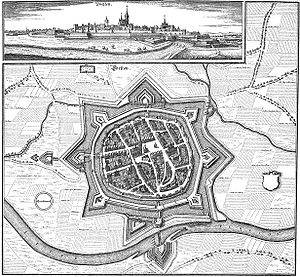Siege of Dorsten
| Siege of the town of Dorsten | |||||||
|---|---|---|---|---|---|---|---|
| Part of Thirty Years' War (Hessian War) | |||||||
 The Town of Dorsten in 1641 by Matthäus Merian. |
|||||||
|
|||||||
| Belligerents | |||||||
|
|
|
||||||
| Commanders and leaders | |||||||
|
Obercommandant Johann von Geyso, Town Commandant Emmanuel Kotz, Colonel Carl von Rabenhaupt (1st relief), Ernest Albert of Eberstein (2nd relief, arrived too late to participate) |
Melchior, Count of Hatzfeldt, Alexander II of Velen |
||||||
| Strength | |||||||
| 2,000 (infantry, cavalry, artillery), 250 men of the Hessian 1st relief force from Haltern, 2nd relief force incl. 3,000 Swedish cuirassiers withdrawn from Wolfenbüttel (too late for battle) | 20,000 (12th Regiment of Infantry, 10th Regiment of Cavalry 30 pieces of heavy artillery) |
||||||
| Casualties and losses | |||||||
| 1,350 killed and wounded | unknown | ||||||
The Siege of Dorsten (German: Belagerung von Dorsten) was a military conflict that lasted from 16 July 1641 to 19 September 1641 during the Thirty Years' War in Europe. The opposing sides were the Landgraviate of Hesse-Cassel and the Holy Roman Empire of the German Nation.
According to a judgement by the Vienna Supreme Court (Wiener Hofgericht), Hesse-Cassel had to cede Upper Hesse, which included the University of Marburg, to Hesse-Darmstadt. In return for this substantial loss, in the Treaty of Werben on 22 August 1631, King Gustavus Adolphus of Sweden promised to grant the state of Hesse-Cassel, various territories including parts of the Prince-Bishopric of Münster (Hochstift Münster) and Vest Recklinghausen (governed by the Electorate of Cologne) if he were victorious in the Thirty Years' War.
On 9 February 1633, Hesse-Cassel captured the town of Dorsten without resistance from the Electorate of Cologne and the Vest of Recklinghausen and, in the years that followed, it was turned into the strongest fortress in the region by the Hessian, Colonel Dalwig, and Johann Adriansch. As early as 1636, an attempt was made under the command of Johann von Götz to recapture Dorsten, but he was met with failure.
On 16 July 1641 a second siege of the town of Dorsten was begun by imperial Field Marshal Melchior, Count of Hatzfeldt and imperial Feldzeugmeister, Alexander II of Velen, with some 20,000 soldiers. This attack was started because, earlier, the Hessian lieutenant general, Kaspar, Count of Eberstein had moved off with a portion of his troops to participate in the Siege of Wolfenbüttel. Whilst the main body of imperial troops were also engaged at Wolfenbüttel, Hatzfeld positioned his forces south of Dorsten, whilst Velen deployed to the north. The Imperial Artillery took post to the northeast amongst the sand hills, initially with 14 cannon. They were later reinforced by the Electorate of Cologne bringing the total to 30 guns. In a letter from the imperial Generalwachtmeister, Freiherr von Wendt, dated 16 July, to the mayor and town council of Recklinghausen, he demanded the following supplies for the provision of his soldiers outside Dorsten: 3,000 pounds of bread, 16 tonnes of beer, four head of cattle, 15 sacks of oats and several "kitchen items". The Barony of Lembeck (Herrlichkeit Lembeck) also had to supply food. In early August, Hatzfeld also fetched four half-kartouwen and two fire mortars (Feuermörser) from Kaiserswerth. The soldiers, who came from the 12th Regiment of Infantry and 10th Regiment of Cavalry, constructed extensive siegeworks around the town.
...
Wikipedia
